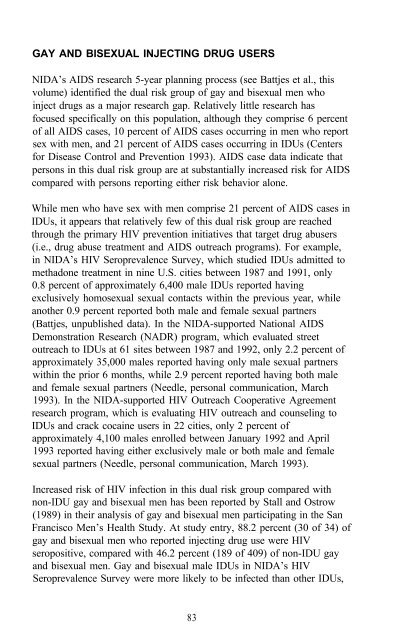The Context of HIV Risk Among Drug Users and Their Sexual Partners
The Context of HIV Risk Among Drug Users and Their Sexual Partners
The Context of HIV Risk Among Drug Users and Their Sexual Partners
You also want an ePaper? Increase the reach of your titles
YUMPU automatically turns print PDFs into web optimized ePapers that Google loves.
GAY AND BISEXUAL INJECTING DRUG USERS<br />
NIDA’s AIDS research 5-year planning process (see Battjes et al., this<br />
volume) identified the dual risk group <strong>of</strong> gay <strong>and</strong> bisexual men who<br />
inject drugs as a major research gap. Relatively little research has<br />
focused specifically on this population, although they comprise 6 percent<br />
<strong>of</strong> all AIDS cases, 10 percent <strong>of</strong> AIDS cases occurring in men who report<br />
sex with men, <strong>and</strong> 21 percent <strong>of</strong> AIDS cases occurring in IDUs (Centers<br />
for Disease Control <strong>and</strong> Prevention 1993). AIDS case data indicate that<br />
persons in this dual risk group are at substantially increased risk for AIDS<br />
compared with persons reporting either risk behavior alone.<br />
While men who have sex with men comprise 21 percent <strong>of</strong> AIDS cases in<br />
IDUs, it appears that relatively few <strong>of</strong> this dual risk group are reached<br />
through the primary <strong>HIV</strong> prevention initiatives that target drug abusers<br />
(i.e., drug abuse treatment <strong>and</strong> AIDS outreach programs). For example,<br />
in NIDA’s <strong>HIV</strong> Seroprevalence Survey, which studied IDUs admitted to<br />
methadone treatment in nine U.S. cities between 1987 <strong>and</strong> 1991, only<br />
0.8 percent <strong>of</strong> approximately 6,400 male IDUs reported having<br />
exclusively homosexual sexual contacts within the previous year, while<br />
another 0.9 percent reported both male <strong>and</strong> female sexual partners<br />
(Battjes, unpublished data). In the NIDA-supported National AIDS<br />
Demonstration Research (NADR) program, which evaluated street<br />
outreach to IDUs at 61 sites between 1987 <strong>and</strong> 1992, only 2.2 percent <strong>of</strong><br />
approximately 35,000 males reported having only male sexual partners<br />
within the prior 6 months, while 2.9 percent reported having both male<br />
<strong>and</strong> female sexual partners (Needle, personal communication, March<br />
1993). In the NIDA-supported <strong>HIV</strong> Outreach Cooperative Agreement<br />
research program, which is evaluating <strong>HIV</strong> outreach <strong>and</strong> counseling to<br />
IDUs <strong>and</strong> crack cocaine users in 22 cities, only 2 percent <strong>of</strong><br />
approximately 4,100 males enrolled between January 1992 <strong>and</strong> April<br />
1993 reported having either exclusively male or both male <strong>and</strong> female<br />
sexual partners (Needle, personal communication, March 1993).<br />
Increased risk <strong>of</strong> <strong>HIV</strong> infection in this dual risk group compared with<br />
non-IDU gay <strong>and</strong> bisexual men has been reported by Stall <strong>and</strong> Ostrow<br />
(1989) in their analysis <strong>of</strong> gay <strong>and</strong> bisexual men participating in the San<br />
Francisco Men’s Health Study. At study entry, 88.2 percent (30 <strong>of</strong> 34) <strong>of</strong><br />
gay <strong>and</strong> bisexual men who reported injecting drug use were <strong>HIV</strong><br />
seropositive, compared with 46.2 percent (189 <strong>of</strong> 409) <strong>of</strong> non-IDU gay<br />
<strong>and</strong> bisexual men. Gay <strong>and</strong> bisexual male IDUs in NIDA’s <strong>HIV</strong><br />
Seroprevalence Survey were more likely to be infected than other IDUs,<br />
83
















